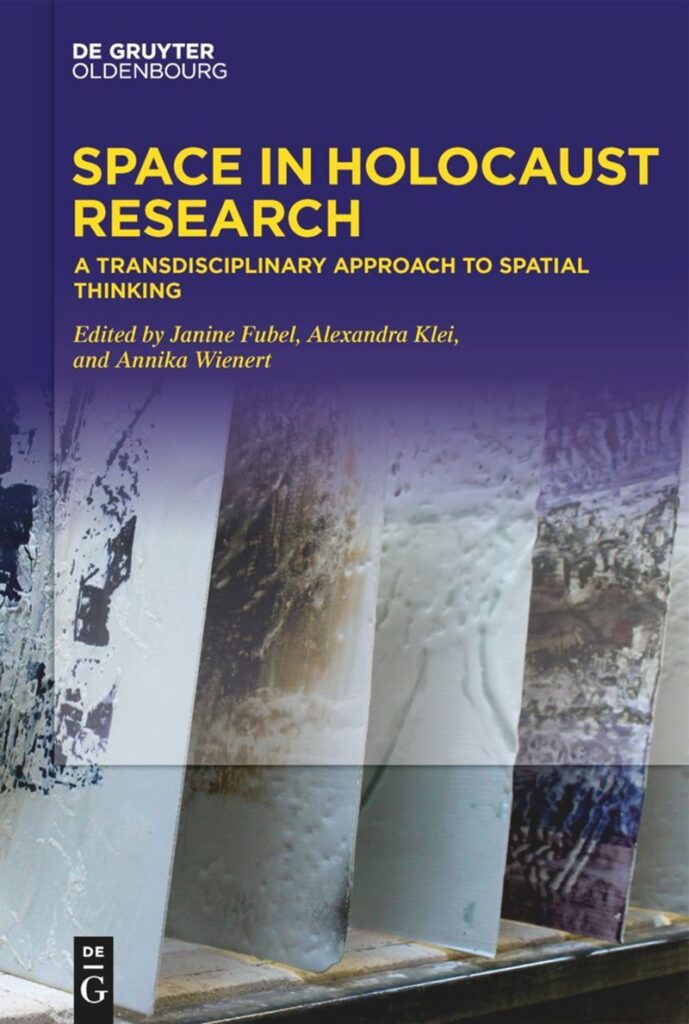
In the traditional historical sense, space in Holocaust Studies encompasses the boundless dystopia of Nazi “Lebensraum” in “the East” on the one end of the spectrum, the genocidal confines of German-controlled Jewish life in ghettos and camps on the other, and somewhere in between the often liminal zones of refuge, self-help and protection. Between these functionally connected phenomena, it is not easy for researchers to orient themselves; if one adds additional dimensions of spatiality¾e.g., aspects transcending the geophysical world towards social, cognitive and sensual perceptions of space¾and the expansive evolution of this academic field, the danger of getting lost increases. In the book under review, researchers find a most valuable beacon of orientation on where the research about space and the Holocaust stands, what challenges and possibilities it raises, and what remains as desiderata for future exploration.
Space in Holocaust Research traverses a remarkably broad range of scholars, educators, and artists from a variety of backgrounds; they reflect on conceptual, topical, and methodological issues within a structural framework developed with great care by the volume editors. Originating from a conference held in Hamburg in early 2020, the book presents a prologue (in the form of images by and reflections on the work of Israeli artist Yael Atzmoni), a brief introduction on “spatial thinking in Holocaust Studies” by the editors, and 19 chapters (four in German with English abstracts) organized in two parts, each with their separate introductory texts. Moving on swiftly from the by now obligatory nod to Holocaust Studies’ various “turns,” the contributors explore what could be called “the primacy of the spatial” with promising heuristic results. The combination of theoretical-methodological approaches (part 1) with case studies (part 2), the absence of a rigid separation between history and its representation, as well as the editors’ preference for multi- and transdisciplinarity situates the book at the cutting edge of academic research; furthermore, it helps guide Holocaust Studies onto comparative fields tilled by geographers, art historians, sociologists, architects, genocide scholars, and Digital Humanities experts.
Despite their topic’s dazzling diversity and the inherent heterogeneity of anthology contributions, the editors manage to achieve volume cohesion effectively and elegantly. Understanding space as “a social, relational, processual, and performative phenomenon” (p. 34), the contributors are given room to freely chart their respective paths while staying within the volume’s conceptual bounds. This is most evident in part 2 in which case studies are organized into broad sections (“Fleeting Spaces,” “Institutionalized Spaces,” “Border/ing Spaces,” “Spatial Relations”) introduced by the editors using a contemporary photo of a Holocaust site as a point of departure, thus embedding their authors’ far-ranging deliberations within concrete spatiality even where the “relative spacelessness” (p. 137) of mass execution sites hinders their localization. Each chapter ends with a helpful bibliography that, given the volume’s focus on space as a social construct, highlight especially works that engage the history of Holocaust persecution, its memorialization and representation.
Among the contributions, several stand out to this reviewer. Historian Eliyana Adler provides an insightful overview about the (English-language) literature on Jewish refugees and their destinations around the world, exemplifying “the Holocaust as a global phenomenon” (p. 59) manifested in local settings and indicating how space-focused research on the Nazi persecution of the Jews can enrich Migration and Genocide Studies. Building on the work of Tim Cole, for Slavic Studies scholar Luba Jurgenson, the study of landscapes broadens the meaning of genocidal space towards the environmental and material in their impact on individual, collective, and communicative memory. Concretion figures prominently too in Anne Kelly Knowles’ refreshing critique of historical mapping conventions with their bias towards documentation, indexicality, and categorical rigidity; instead, Knowles points at memory maps and digital mapping projects (including her own on ghettos in the German-occupied “East”) to overcome both “ranked symbolization and exclusion of lesser spaces” (p. 96) and “location bias” (102) still prevalent in Holocaust Studies in favor of “iterative, exploratory, and graphical experimental [map] design” (p. 106 n. 51).
A similar flattening of space and its meanings continue to mark filmic representations of space explored in the intriguing chapter by Sue Vice and Dominic Williams, i.a. based on outtakes from Claude Lanzmann’s Shoah and Chantal Akerman’s oeuvre. Investigating the production stages of Lanzmann’s movie, the authors observe a reduction of social space by way of excluding scenes of family interaction discernible in the outtakes that contrasts sharply with Akerman’s attempts to locate “private life’s suffusion with history” (p. 190). The importance of institutionalized space is investigated by Christhardt Henschel (on the impact of war-time mobility restrictions, racial segregation, and other German measures on the Polish-German border region of Ciechanów/Zichenau) and, with regard to mass killing monuments as landmarks (“space-makers,” p. 229), by Gundula Pohl whose fascinating case study of the theme-park-like Trascjanec memorial complex near Minsk (Belarus) highlights the different, at times diverging influences and interests by multiple stakeholders¾from survivors to pressure groups to politicians¾that determine the material outcomes of memorialization. Pohl’s findings are echoed in the chapters by Chad A. Gibbs (on “Treblinka Geography”), Thomas Pekar (on the Shanghai-Hongkou-Tilanqiao memorial space), and Anne Mertins (on the Mahn- und Gedenkstätte Ravensbrück).
Readers most interested in Jewish spaces during the Holocaust find stimulating insights throughout the volume, most notably in the contributions by Adler, Knowles, and Yaakov Borut (on German Jewish spaces before and after 1933). Still, given the range of expertise represented by the authors assembled in this book, perhaps more ground could have been covered. Particularly a closer look at the interrelation between Nazi ideas, some materializing in architectural designs and building projects, on the one hand, Jewish spaces¾both defined by Jews as well as by the majority population in the countries they inhabited¾on the other, would have enriched this useful book even further.1 But this is not to say the book lacks explanatory potential; in fact the opposite is the case. Space in Holocaust Research provides a rich roadmap for researchers of many disciplines for surveying space as an analytical factor intertwined with the Holocaust and mass violence in general.